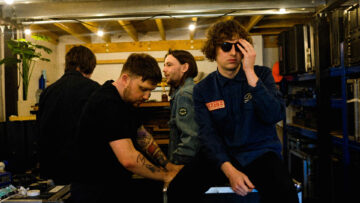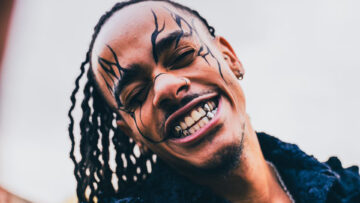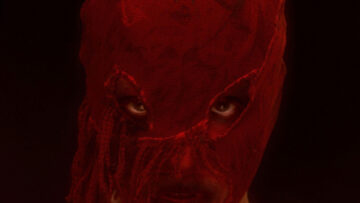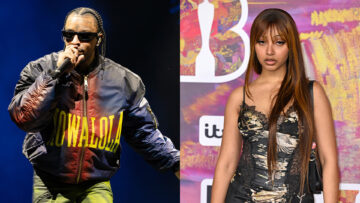
If you ask ten people who they would sculpt onto the Mount Rushmore of rap, there’s a very good chance all of them have both Biggie and Tupac carved into the rock.
Their music defined 90s pop culture and set a standard for Hip-Hop. Without Biggie, you don’t get the smooth virtuosity of Jay Z, without Tupac you never hear the growl of DMX.
Much is made of their feud, the violence and the earth-scorching diss tracks that were exchanged but not so much the symmetry of the rest of their lives, and not so much of the way both pushed the other to become better musicians and to create better art.

Both were raised by strong, single women in tough circumstances. Biggie’s mum was a teacher and took on an additional job after her partner and Biggie’s father walked out when he was two – she also studied for a Master’s degree – education was paramount in the Wallace household: the key to self-determination and freedom. As a result, the young man named Christopher excelled in school, it’s no surprise his best subject was English.
The life of a young Tupac Shakur was not so different. He only met his birth father in adulthood and his mother, a notable Black Panther member and all-round revolutionary, Afeni Shakur, also put great emphasis on knowledge and Pac, like Biggie thrived at school. In his case it was a performing arts school where he became well-regarded for his readings of Shakespeare. As a teenager it’s clear to see he could already read the parables of similarity to gang warfare, and his incredible skill at dancing.
Tupac was still a teenager in 1991 when his debut, the poetic, starkly descriptive portrait of inner city poverty 2Pacalypse Now came out. By the time he and Biggie first connected two years later Shakur was a platinum selling rapper and movie star whereas Biggie was little known outside of Brooklyn. Tupac thought highly of Biggie’s ability and is thought to have played his first solo single ‘Party and Bullshit’ endlessly on the set of John Singleton’s brilliant road movie Poetic Justice in which he co-starred alongside Janet Jackson.
ArrayVery quickly, the two became like brothers. Shakur saw the talent of the young B.I.G and his smooth flows, taking him on as a protégé and letting him perform at his concerts. If Biggie was in LA, there would always be space in Pac’s house for him and if Shakur was on the East Coast, he’d go out of his way to make the man who would become his sworn enemy feel special – hiring limos to take him around town and playing dice and card games with guys from the neighbourhood.
A now iconic moment in their relationship is the freestyle battle they took part in at Madison Square Garden in New York. Part of the Budweiser Superfest, the freestyle was not intended to be a part of the show, already headlined by soul legend Patti LaBelle and with Big Daddy Kane as the lone rap act on the lineup.
Because B.I.G. was close to Kane and his DJ, DJ Mister Cee, they gave him a call to build on the heat that was burning around him after the release of ‘Party and Bullshit’. Tupac was at the venue as a fan and the whole plan for the freestyle was put together backstage.

Tupac Shakur and Tim Roth in ‘Gridlock’d’, 1997. (Photo: Gramercy Pictures)
Spitting over a boom-bap beat, B.I.G. went first. Though far from the complete product he’d be a year later, the freestyle captures the ease with which he could flow through syllables and also his effortless knack for finding a hook – in this case the refrain of ‘where Brooklyn at’. Lyrically, it’s a pretty infantile song with references to pigeons defecating and assaulting babies but already at this stage, he’s a superstar in waiting.
In contrast, Tupac is pure apocalyptic rage, every fibre, cell and muscle is thrown behind every word, he raps like the world is ending, he sounds desperate, his brain consumed by pain and paranoia with lyrics revealing an increasingly violent state of mind. Indeed, within 12 months he would get into a shoot-out with two off-duty cops, assault film director Allen Hughes and stare down imprisonment for sexual abuse.
Not long after this epic on-stage freestyle, Biggie wanted Tupac to act as his manager.
Though today, we know Puff Daddy as a titan of the music world, back in 1993 his Bad Boy Records was the new kid on the block. Born out of Puff getting fired from Uptown Records (who B.I.G. was originally signed to), Biggie left Uptown to join Bad Boy – out of loyalty to the man who first recognised what he could bring to the rap game. Though Biggie had wanted Pac to manage him – jealous of his riches and records – the latter told him that Puff would “make him a star”. And he did.

From here, the relationship rapidly unravelled. Tupac was filming Above the Rim in New York when he met Haitian Jack Agnant, a club promoter and drug dealer who, like Pac, had a romantic history with Madonna. The Brooklyn born and bred Biggie warned Pac away from Jack, who behind the Versace shirts and shimmering Rolexes was known as a serious individual it was best to not get on the wrong side of – a proper gangster.
Their brief friendship ended soon at the Park Meridian Hotel where Tupac was accused and later convicted of abusing a woman. Though Haitian Jack was in the room that night and they were arrested together, the gangster’s case was separated from Shakur’s and dropped to a misdemeanour and no prospect of jail time. Pac smelt a rat and told the press in no uncertain terms that he thought Jack was a snitch. It was also around this time he started associating with Jimmy Henchman, a music manager by day and gangster by night.
Their tale would end with a symmetrical explosion of violence but amongst those dark days was an outpouring of staggering art.
Already strained by Tupac’s increasingly belligerent and wild behaviour, his relationship with Biggie was permanently severed in the winter of 1994. Shakur arrived at the Quad Recording Studios to lay down a guest verse for Henchman-managed rapper Little Shawn. Biggie was recording in one of the upstairs studios with Puff. As he entered the elevator, guns were drawn on Shakur and his associates, ordered to the floor to be robbed of their cash and jewellery.
But Tupac, who by this point had morphed his outlaw persona into his real life, responded by drawing his own weapon and was shot five times and left for dead. Haemorrhaging blood he rode the elevator and found Biggie, Puff and Henchman upstairs and who in Tupac’s words “looked guilty”. He became convinced beyond reason that they were behind the attack that left him needing surgery.

1st December 1994. (Photo: Krusberg)
Days later, a wheelchair-bound Tupac would be convicted and sentenced 18 months in prison. Whilst locked up, Shakur raged at the perceived betrayal of the man he had once housed and showered with gifts and support. In his mind, he just couldn’t believe that Biggie hadn’t known about the shooting that occurred in his neighbourhood.
Enter Suge Knight.
Outside of prison, in the increasingly violent hip-hop world, former NFL player and Death Row Records head honcho, Suge, with the backing of Jimmy Iovine’s Interscope had become one of the biggest players in music with a reputation for intimidation and violence and had Puff’s Bad Boy in his sights.
At the 1995 Source Awards, Suge used his mic time to rip into his New York counterpart, mocking him for dancing in his artist’s videos and ad-libbing on all their songs. He finished by making an open call for any artist wanting the spotlight for themselves to come to Death Row. The outburst took the music industry by surprise, Suge and Puff had always been cool with each other before but before heading to the ceremony, Knight had visited Tupac in prison and together, in vengeance for the shooting, promised to destroy Biggie, Puff and Bad Boy Records.

Before Knight coughed up Shakur’s extortionate bail money, Biggie released ‘Who Shot Ya’ which started the war on wax. Pac heard the record and whilst he was never named on the track, he interpreted it as the most audacious taunting, a mocking of his shooting and imprisonment.
As the newest member of the Death Row roster, Tupac went to war with his one-time friend, refusing to let ‘Who Shot Ya’ go unanswered, calling out Biggie and Puff in every interview, making sure the whole world knew he thought they were behind his shooting. And then ‘Hit Em Up’ dropped.
It was the angriest anyone had ever heard Tupac. He mocked Biggie’s weight, said he’d slept with his wife, Faith Evans, and mocked his rapping, claiming his style was bitten from Shakur. There was no coming back. In response, Biggie and Puff continued to plead innocence and attempted to cool the feud but all Tupac wanted was violent payback that would never come.
Their tale would end with a symmetrical explosion of violence but amongst those dark days was an outpouring of staggering art.
Without Pac’s prison sentence, he would never have hooked up with Dr Dre and evolved his sound and made the irrepressible California Love. Without the anger, we would never have gotten the experimental The Don Killuminati: The 7 Day Theory which exposes the tortured artist at his most vulnerable.
Biggie’s posthumously released Life After Death was his towering achievement, an ode to his dual personality of the love and hate at the heart of him. It was gangster, it was pop, as vivid as cinema and as introspective as the novel and count amongst its descendants The Blueprint and Get Rich or Die Tryin.
The jealousy and undying that each had for the other undeniably pushed them to improve their craft, improve their collaborators and improve their art.
Looking back at the 90s, it’s impossible to think of the era without hearing the music of Biggie and Pac and the artists currently on the radio in debt to them – the Kendricks, the J Coles, you can trace their success right back to this artistic, violent, and commercial zenith.




